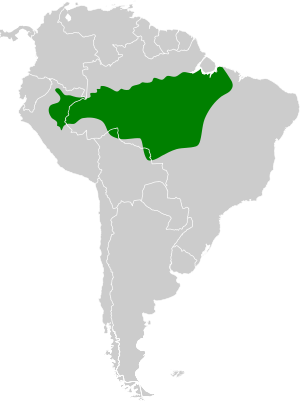Rufous-necked puffbird facts for kids
Quick facts for kids Rufous-necked puffbird |
|
|---|---|
 |
|
| Conservation status | |
| Scientific classification | |
| Genus: |
Malacoptila
|
| Species: |
rufa
|
 |
|
The rufous-necked puffbird (Malacoptila rufa) is a cool bird known for its fluffy look! It's part of a bird family called Bucconidae, which includes puffbirds, nunlets, and nunbirds. You can find this special bird in countries like Bolivia, Brazil, and Peru in South America.
Contents
About the Rufous-necked Puffbird
Scientists like to group living things to understand them better. This is called taxonomy. The rufous-necked puffbird has two main types, or subspecies. These are M. r. rufa and M. r. brunnescens. They are very similar but have slight differences in their colors.
What Does It Look Like?
The rufous-necked puffbird is about 18 cm (7.1 in) long. That's about the length of a standard pencil! It weighs around 39 to 46 g (1.4 to 1.6 oz), which is lighter than a tennis ball.
This bird is a bit unusual for a puffbird because it doesn't have stripes. Its head and cheeks are dark gray with thin, light lines. It has a bright, reddish-brown spot near its beak. A wide reddish-brown collar goes around its neck.
The bird's back is dark brown, and its wings and tail are a warmer brown color. Its belly is lighter brown, while its chest is darker. There's a white curved line on its upper chest, with a thin black line just below it. The beak can be blue-gray or black. Its eyes are dark brown or red, and its feet are light gray-brown.
The M. r. brunnescens subspecies looks very much like the main type. The main difference is how strong the colors are.
Where Does It Live?
The rufous-necked puffbird lives in the southern part of the Amazon rainforest.
The M. r. rufa subspecies lives in parts of northeastern Peru, northeastern Bolivia, and western Brazil. This area is south of the Amazon River and west of the Madeira River.
The M. r. brunnescens subspecies lives in Brazil, south of the Amazon River. It is found east of the Tapajós River all the way to the Atlantic Ocean. In some areas between the Madeira and Tapajós rivers, you might find birds that are a mix of both subspecies.
Most of the time, these birds live in the lower parts of evergreen forests. These are forests where trees stay green all year. In northeastern Peru, they seem to prefer a special type of forest called várzea forest.
How Does It Behave?
Eating Habits
The rufous-necked puffbird likes to hunt from a branch a few meters above the ground. It quickly flies out to catch its food from plants or the ground. Scientists haven't studied its diet a lot. But we know it mainly eats insects and other small creatures without backbones. It might also eat very small animals with backbones.
Sometimes, these puffbirds join groups of different bird species that are hunting together. They also sometimes follow army ant swarms to catch insects that the ants stir up.
Life Cycle
We don't know much about how rufous-necked puffbirds raise their young. Only one nest has ever been found. It was in a tunnel dug into the ground.
Bird Calls
The song of the rufous-necked puffbird is a long, musical trill that goes down in pitch. It sounds very much like the songs of the White-chested and Semicollared puffbirds.
They also make other sounds. These include a thin "seeeee" whistle. When they are upset, they make a harsh, scratching sound like "trr'r'r'r'r-SHEEAH trr'r'r'r'r-SHEEAH trr'r'r'r'r-SHEEAH...".
Is It Safe?
The IUCN (International Union for Conservation of Nature) says the rufous-necked puffbird is a species of "Least Concern." This means it is not currently in danger of disappearing.
It lives in a very large area. However, scientists don't know exactly how many of these birds there are. They believe the number of puffbirds is slowly going down. Luckily, no specific threats to this bird have been found yet.
See also
 In Spanish: Buco cuellirrojo para niños
In Spanish: Buco cuellirrojo para niños


